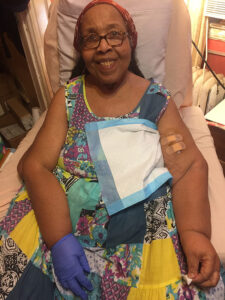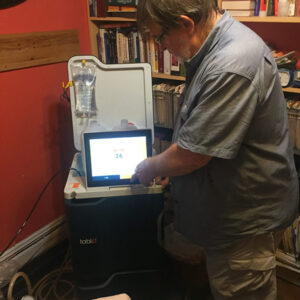It’s Like a Dream: Letisha’s Home Hemodialysis Journey with Tablo

Summary
Diagnosed with kidney disease 20 years ago and her mobility limited by a stroke, Letisha is happy to be at home with Tablo, and is passionate about encouraging other patients to get educated about this life-changing option.
Letisha lives in Brooklyn, New York with her husband of 53 years, Damon. After more than 20 years on dialysis, including in-center and home hemodialysis, and 10 years following a stroke, Letisha wants newly diagnosed CKD patients to know that dialysis is not like what they might fear, or the often-negative depictions of it in the media. In 2022, she began using the Tablo® Hemodialysis System at home, and feels the ease of use of the technology can help make dialysis accessible to more patients at home. And it goes hand in hand with her long-time passion of helping patients learn more about their dialysis options so they can make the best choice possible for their needs and lifestyle.
“I have a high quality of life. I highly recommend Tablo over all other machines for first-time dialysis users, or those who have used other machines. It’s a timesaver and a space saver,” she says. “It’s like a dream. If I had to choose a machine, I would definitely choose Tablo. I feel my health outcomes are directly related to being able to be home and do my dialysis when it works for me, especially with a patient-friendly machine like Tablo.”
Health Journey into Dialysis
Letisha has a family history of kidney disease, with both her mother and uncle having been on dialysis, and her grandmother passing away from kidney failure. But when she was younger, she didn’t think much about how it could impact her, and continued on with her life.
Then, when she was in her 50s, more than 20 years ago, her doctor told Letisha that within six months she would be on dialysis and be diabetic. She was shocked by his statement and decided to take a proactive approach to her health. She saw a naturopathic doctor who helped her change her diet. She was able to stave off dialysis for two years, long past the doctor’s prediction, and has never developed diabetes.
She started going to a nephrologist at State University of New York (SUNY), who mentioned to Letisha she might be a good candidate for home hemodialysis. At the time, she had never heard of it. She was very interested in learning more, as she was working full-time as director of childcare services at a nonprofit agency and wanted to keep working.
In June 2003, she had arteriovenous fistula surgery in her left arm, and that September she began training at SUNY for home hemodialysis. She recalls the machine training was very intensive, for both herself and her husband, including having to study large notebooks of information.
During this time, as she has an open mind about trying new technologies that might help advance the field and encourage more patients to benefit from home hemodialysis, she participated in a clinical trial for an investigational home machine. However, it didn’t work well, so she returned to using her previous machine at home. After she started on treatment, Letisha also volunteered her time both in-center and at a hospital renal clinic to help educate other patients about home dialysis as an option.
In 2013, Letisha’s life took a dramatic turn when she had a stroke. She was completely paralyzed on her left side and spent 100 days in a nursing rehabilitation facility. She now uses a walker in her home and an electric wheelchair for traveling around outside of her home. During her stroke rehab they didn’t have dialysis available at the facility, so she had to be taken on a stretcher and ambulance to a dialysis center three times a week. “It was a nightmare being taken away on a stretcher, and it was also tough because it was wintertime in New York City,” she says.
A year later she was ready to return to home hemodialysis with the help of her husband, but Letisha’s nephrologist at SUNY was no longer offering the modality. So, she was back to in-center treatment, which she hated. Compared to being able to manage her dialysis herself in the comfort of her own home, she and her husband were inconvenienced by the assigned 6 a.m. chair time, the only option available.

“It wasn’t a pleasant environment. I was used to being able to treat from the comfort of home, and although it was difficult with the older machines, at least I had flexibility,” she says. “Patients are connected passively to a machine in-center, but usually not connected to their options.”
She had also been assigned a different nephrologist, but with her many years of experience she preferred the more cohesive and connected relationship she had with her previous nephrologist. She continued to look for a care team that could better help her.
A Connection and a Big Change
Then, based on the life-changing recommendation of a dialysis technician who Letisha knew from years before when he was an in-center patient as well, she switched to a different care team in New York. This team is the close and cohesive group she had been looking for, and who she is still with today.
She then trained on an older-technology home dialysis machine that she feels hadn’t changed much since she had used it many years before. She also participated in a second clinical trial for an investigational machine, but it didn’t work for her. From 2014 to 2022, Letisha kept looking for ways to make the home dialysis experience better.
Making Home Hemodialysis Fit Around Your Life

In early 2022, her nephrologist introduced her to a new device, Tablo, at a training center near her home in Brooklyn, and she was excited at first sight. “Tablo looked impressive. It’s smaller, there’s no reverse osmosis machine or dialysate bags. This a step up towards what [the field of] home dialysis could and should be,” she says. “As I learned more about it, I thought this machine was designed so well. The touchscreen is genius, so easy to use. Tablo is going to be a real boon for people with CKD. Everybody deserves a chance to explore it as an option. It’s going to take away much of the set-up time you see with other machines.”
Since starting on Tablo at home in March 2022, Letisha appreciates the flexibility of being able to enjoy time with family and friends—and just do normal things—since she can schedule her hemodialysis when it works for her and Damon. Her husband adjusts his schedule as a psychotherapist around Letisha’s needs. She treats at home four days a week, five hours each time, on Tuesday, Wednesday, Friday and Sunday, starting usually about 6 pm.
They set up their Tablo machine in about 20 minutes, and Damon cannulates her for each treatment. They usually have dinner together during her dialysis, play Scrabble, or Letisha enjoys reading library books on her tablet. They can take their time and adjust treatment times as needed. Their son assists by bringing supplies from a downstairs room. Letisha also enjoys cooking, with help from her husband and son. Her husband grows a variety of fresh vegetables in their hydroponic garden, including cucumbers that Letisha enjoys pickling. “I’m very blessed with family and friends who care about me,” she says.
“I’ve learned over the years you can train on a machine, but then you have to be able to live your life with the machine once you get home,” she continues. “Tablo makes home treatment much easier. It’s far and above any other machine I’ve used. I couldn’t go back to the previous machines.”
She also says she appreciates the support of the Outset team. “I feel like it’s almost magic how helpful they are with any issues we have. Outset representatives know everything about the machine and can check on me remotely,” she says.
The Future Depends on Patient Education
Letisha says with her many years of dialysis experience, she sees a huge disconnect with the lack of patient education to choose the dialysis modality that works best for them, most importantly home hemodialysis.
“So many times over the years, I have seen dialysis centers with a training room just down the hallway, that sits there empty. Meanwhile, patients spend countless hours of their life dealing with the stress of in-center dialysis, getting to and from the center, waiting in the waiting room, and other things I don’t have to tolerate anymore. That was really eye opening to me. We need to remove these barriers and make sure that people can make an informed decision about their modality of choice, and look at Tablo as an option before they need dialysis,” she says.
Photo at top of page: Letisha at home in Brooklyn, NY preparing for treatment on her Tablo Hemodialysis System.
The views and opinions expressed in this blog post represent the personal opinions of the parties interviewed. The content should not be taken as medical advice. Never ignore professional medical advice in seeking treatment because of content you have read on the Outset Medical website.

